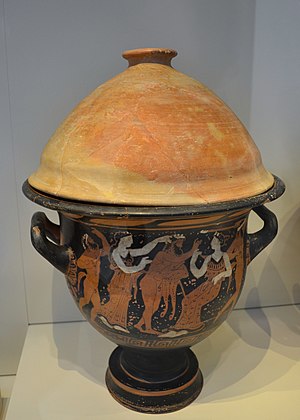Krater
Contenido keyboard_arrow_down

Quarry Bell exhibited at the National Archaeological Museum of Spain. It's made in clay and it's from the s.IVa. C. It was found in the necropolis of Villaricos (Almeria), in the 52-I tomb and served to deposit the remains of an incineration. It is decorated with satyros figures (country and lascivious divinity), a ménade (Baco priesthood) and Ariadna on the face A, and three young with himatión (mantle) on face B.
A krater or crater (from the Greek κράτηρ) is a large-capacity ceramic vessel designed to contain a mixture of water and wine with which glasses were filled; The ancients seldom drank pure wine. It was taken to the place of food and deposited on the ground or on a platform. The cupbearer (called in Latin pincerna or pocillator) administered the liquid with a ladle or kyathos (called in Latin cyathus) and filled the cups (pocula or chalices) of the guests.
Types
The kraters were made of clay and precious metals and were modeled in different shapes according to the artist's taste. He always had a very wide mouth. The most widespread forms that have been found in excavations are:
- Column pathway, with vertical handles such as fuses, which are ripped by a horizontal slope. It's the oldest form.
- Voltage. It is called so because its handles, which stand above the mouth, form volutes, that is, in the form of spiral or snail. They kept up to the s.IVa. C.
- Calyx Roadwhich recalls the chalice of the flowers and whose profile is almost inverted. He's a more modern guy than the previous two.
- Bell crater, with outgoing handles and directed upwards and shaped like an inverted bell. It is a type of late use, of the final period of the cup paintings.
Contenido relacionado
Flag of Guinea-Bissau
Song (lyrical)
Neolithic
Más resultados...



